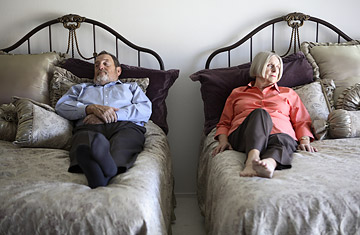
Sex and older generations: it’s not a topic that gets discussed much, not even in the doctor’s office. But some physicians say that needs to change, because older patients are leading active sex lives — and their rates of sexually transmitted diseases may be on the rise.
Whatever the cause — Viagra, midlife divorce, online dating or simple ignorance — studies suggest that STDs are no longer just an affliction of the young. A study published online last week by the journal Sexually Transmitted Infections adds to that growing body of evidence. Researchers at England’s West Midlands Health Protection Agency found that in less than a decade, STD rates had more than doubled among people ages 45 and older. And Dr. Babatunde Olowokure, an author of the study, thinks that figure may be low. “These observations are based on a small proportion of people who actually attend clinics,” he says. While that proportion of the population has increased overall over the past decade, Olowokure points out that middle-aged and older people tend to delay visiting a doctor for treatment of an STD, or they avoid it altogether, in large part due to the stigma associated with sexually transmitted infections.
In their study, Olowokure and his team counted 4,445 infections reported to 19 clinics in the region. From 1996 to 2003, total cases of chlamydia, genital herpes, gonorrhea, syphilis and genital warts among people over 45 increased 127%, from 344 cases in 1996 to 780 in 2003. Rates of STDs increased in patients under age 45 as well, by 97%, during the same time period. In the U.S. the most recent Centers for Disease Control and Prevention figures — which include prevalence of syphilis, chlamydia and gonorrhea — reflect relatively stable rates of infection in people ages 55 and older, but that data relies on self-reporting, and in many parts of the country it is out of step with what physicians are seeing. “Our rates of syphilis and chlamydia are up across all ages,” says Dr. Sharon Lee, a Kansas City, Mo., family physician and medical director of HIV Wisdom for Older Women. According to a 2000 study of Washington State residents, one of the only comprehensive analyses of STD infection among the middle-aged and older, cases of gonorrhea increased 18.2% between 1997 and 1998 among people ages 45 and older; in younger people, that increase was 17.3%.
Researchers point to myriad factors contributing to the rise in STD instances, among them a high midlife divorce rate and the ease of finding dates online. “What we have in this age group is a lot of people who are separated or divorced and seeking relationships. Sometimes they obtain them via the Internet, where they don’t know the person and they don’t know their sexual history,” says Olowokure.
But perhaps the most critical reason is older generations’ lack of sex ed. Many older adults may have an outdated view of safe sex, believing that condoms are unnecessary after menopause or with partners they already know. Lee points out that “as people get older, they don’t worry about pregnancy as much,” and without education about STDs, many believe an inability to get pregnant negates the necessity for protection.
That was the mistake Jane Fowler, 74, a co-founder of HIV Wisdom for Older Women, made after divorce ended her 24-year marriage. A self-dubbed “1950s good girl,” Fowler had only ever had one partner — her husband. Newly single in her early 50s, she started dating a man she’d known her entire life, and pregnancy was no longer a concern. “If you know for a fact that you can’t become pregnant and you don’t know anything about sexually transmitted diseases,” she says, “why would you use a condom?” Five years later, a routine blood test revealed that she had contracted HIV.
Thousands of adults like Fowler find themselves renegotiating sex in singlehood, after years or even decades of marriage, and they are in need of the same kind of sex-ed their grandchildren get. In a University of Chicago survey of single women ages 58 to 93, nearly 60% said they didn’t use a condom the last time they had sex. A May 2008 study conducted by the New York Department of Health and Mental Hygiene showed that among single people with at least two sexual partners, 56% of people over age 45 reported using condoms the last time they had sex, compared with 61% of 25-to-44-year-olds and 80% of 18-to-24-year-olds.
Among the 45-and-over set, senior citizens in particular have little exposure to sexual-health information, and few places to seek it out. Primary-care physicians would be the natural source, but Lee worries that too many doctors avoid the topic because they feel uncomfortable discussing it with older patients, or worse, they make the “dangerous assumption that older people are not engaging in sex after a certain age.” That lack of communication perpetuates ignorance. So, Lee says that until comprehensive sex-ed measures are established for older people, it may fall to younger generations to teach their elders about the birds and the bees. “It used to be that you encourage parents to talk to their kids,” says Lee, “but now we’re encouraging kids to talk to their parents — and grandparents.”